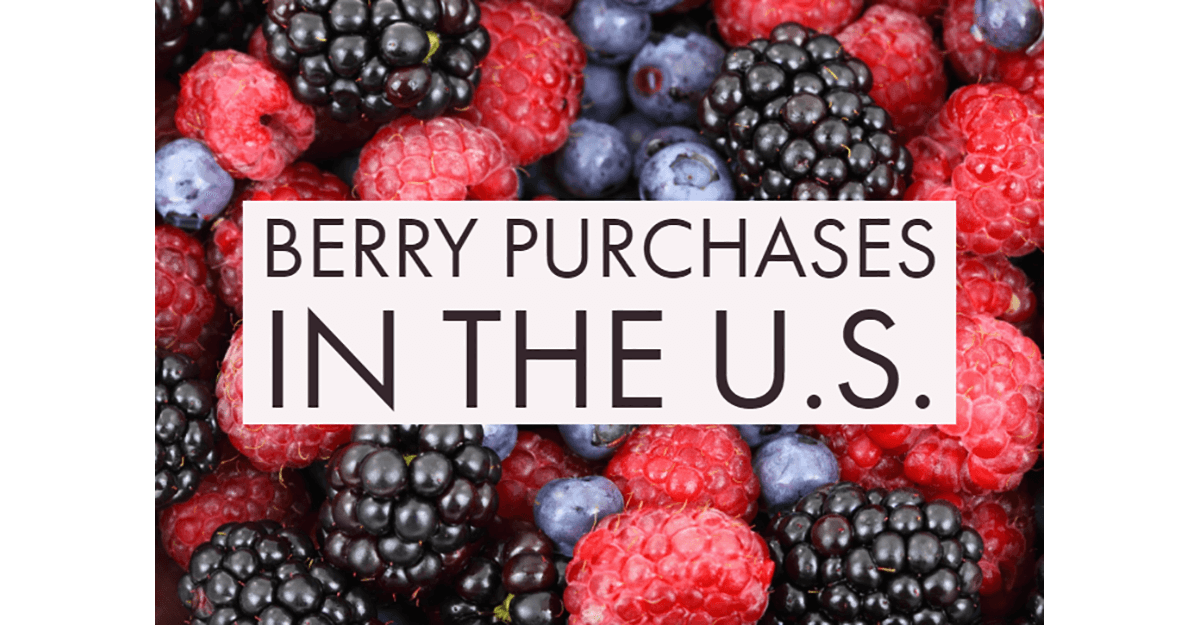How do berry purchases vary by region? Scroll down for an infographic that compares consumption across the country.
Blueberries
This antioxidant-rich superfood is showing up in more consumers' carts. Blueberries were the No. 4 item that shoppers said they are buying now that they did not buy previously, as was the case last year. Income clearly influences blueberry purchases, with shoppers in the top income bracket being the most likely to buy the berries overall. In fact, they were more than twice as likely to buy blueberries as those earning less than $25,000 annually.
Age also plays a role. The likelihood of a purchase increased according to age, and shoppers age 59 and older were among the most likely to buy blueberries overall.
Shoppers in the “all other” ethnic group and Caucasian consumers comprised some of the top groups to buy blueberries, both when considering ethnicity and overall. In contrast, African American shoppers and Hispanic consumers were the groups least likely to make a blueberry purchase overall.
Interest in organic blueberries slipped this year. Thirty percent of buyers said they bought organic blueberries at least some of the time, down from 39% last year. Fifteen percent said they always bought organic berries, a number down two percentage points from last year.
Blackberries
The likelihood of a blackberry purchase increased according to income and age. Shoppers earning more than $100,000 annually were more than twice as likely to buy the dark-hued berries than those in the lowest income bracket, a trend now in its fifth year.
Interest in organic blackberries shot up this year. The berries came in as the No. 3 item that shoppers bought organic at least some of the time and the No. 3 item that consumers purchased as exclusively organic. When it came to exclusive organic purchases, blackberries showed the highest year-to-year growth of any commodity. Eighteen percent of buyers said they always selected organic berries, a number up six percentage points from Fresh Trends 2018.
Families with two children in the home and shoppers living in the West were the most likely to make an exclusive organic blackberry purchase. Forty-four percent of buyers said they opted for organic blackberries at least some of the time.

Cranberries
Though they're one of the least-purchased items in the Fresh Trends survey, these tart berries are a seasonal favorite with many families. The likelihood of a cranberry purchase slipped one percentage point from last year.
The most affluent consumers are the most likely to buy this red fruit. In fact, shoppers earning more than $100,000 annually are nearly twice as likely to buy cranberries as those earning $50,000 or less.
Region also plays a role—shoppers in the South were among the most likely to buy the berries, while those in the Midwest were among the least likely to buy. African American shoppers and those in the “all other” ethnic group were less likely to clamor for cranberries than those of other ethnicities.
Raspberries
For the eighth straight year, the likelihood of a raspberry purchase increased according to income. Consumers in the top income bracket were twice as likely to buy the berries as those earning $25,000-$50,000 annually, and they were the most likely overall to make a purchase.
Raspberries were popular with a couple of ethnic segments—Caucasian consumers and those in the “all other” category. African American shoppers were the least likely to buy the fruit overall.
Consumers showed quite an interest in organic raspberries this year. Raspberries tied with papayas as the No. 4 item that shoppers bought as exclusively organic. Seventeen percent of buyers said they always selected organic raspberries, up from 12% who said the same last year.
Strawberries
These attractive red berries tied with grapes for the title of No. 2 fruit in the Fresh Trends 2019 survey (although the title of No. 1 fruit also saw a tie this year between bananas and apples). The berries were the sixth most popular commodity overall this year.
Strawberries are popular among all segments of the population. Three-quarters of shoppers age 59 and older said they bought the red fruit in the past year, which makes them the most likely group overall to buy.
For years, families with kids had been more likely to buy strawberries than those without kids, but Fresh Trends has seen a shift in that trend during 2018 and 2019. This year families without kids, at 64%, were more likely to buy strawberries than those with kids, at 61%. Consumers with one child living at home were more apt to make a purchase than those with more kids at home.
The likelihood of a strawberry purchase generally increased according to income, with consumers earning $100,000 or more annually being among the most likely to buy overall.

